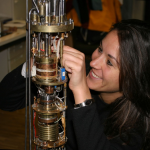

- Photon Transport in a Bose-Hubbard Chain of Superconducting Artificial Atoms
G. P. Fedorov et al., Phys. Rev. Lett. 126, 180503 (2021) - Path-Dependent Supercooling of the
He3 Superfluid A-B Transition
Dmytro Lotnyk et al., Phys. Rev. Lett. 126, 215301 (2021) - Superconductivity in an extreme strange metal
D. H. Nguyen et al., Nat Commun 12, 4341 (2021) - High-Q Silicon Nitride Drum Resonators Strongly Coupled to Gates
Xin Zhou et al., Nano Lett. 21, 5738-5744 (2021) - Measurement of the 229Th isomer energy with a magnetic micro-calorimeter
T. Sikorsky et al., Phys. Rev. Lett. 125 (2020) 142503
Determination of the neutrino mass by electron capture in 163Ho and the role of the three-hole states in 163Dy
A. Faessler, C. Enss, L. Gastaldo, F. Simkovic163Ho to 163Dy is, probably due to the small Q value of about 2.5 keV, the best case to determine the neutrino mass by electron capture. The energy of the Q value is distributed between the excitation of dysprosium (and the neglected small recoil of holmium) and the relativistic energy of the emitted neutrino including the rest mass. The reduction of the upper end of the deexcitation spectrum of dysprosium below the Q values allows us to determine the neutrino mass. The excitation of dysprosium can be calculated in the sudden approximation of the overlap of the electron wave functions of holmium minus the captured electron and one-, two-, three-, and multiple hole excitations in dysprosium. Robertson [R. G. H. Robertson, Phys. Rev. C 91, 035504 (2015)] and Faessler and Simkovic [A. Faessler and F. Simkovic, Phys. Rev. C 91, 045505 (2015)] have calculated the influence of the two-hole states on the dysprosium spectrum. Here for the first time the influence of the three-hole states on the deexcitation bolometer spectrum of 163Dy is presented. The electron wave functions and the overlaps are calculated self-consistently in a fully relativistic and antisymmetrized Dirac-Hartree-Fock approach in holmium and in dysprosium. The electron orbitals in Dy are determined including the one-hole states in the self-consistent iteration. The influence of the three-hole states on the Dy deexcitation (by x rays and Auger electrons) can hardly be seen. The three-hole states seem not to be relevant for the determination of the electron neutrino mass.
Phys. Rev. C 91, 064302 (2015)
doi: 10.1103/PhysRevC.91.064302















